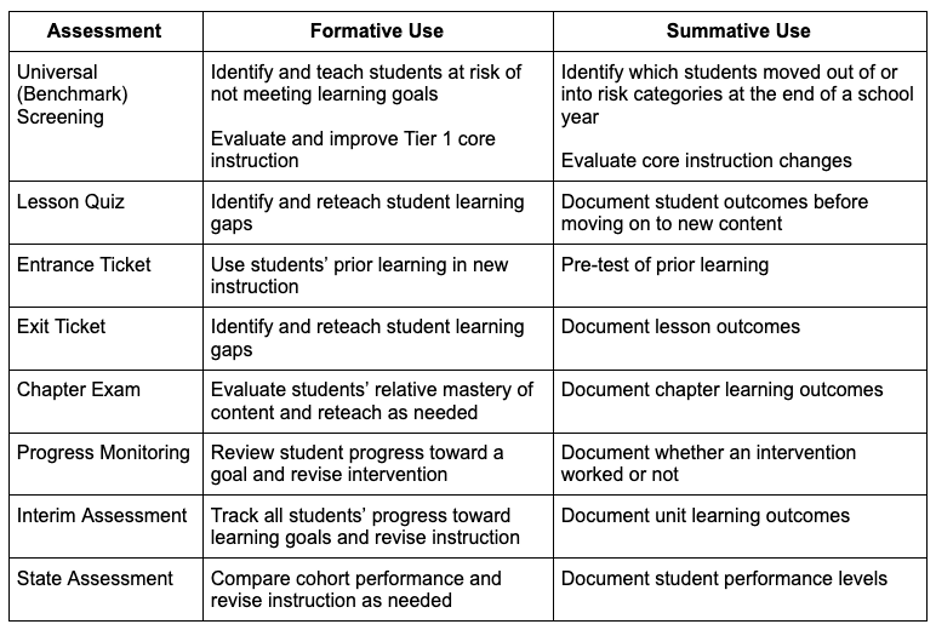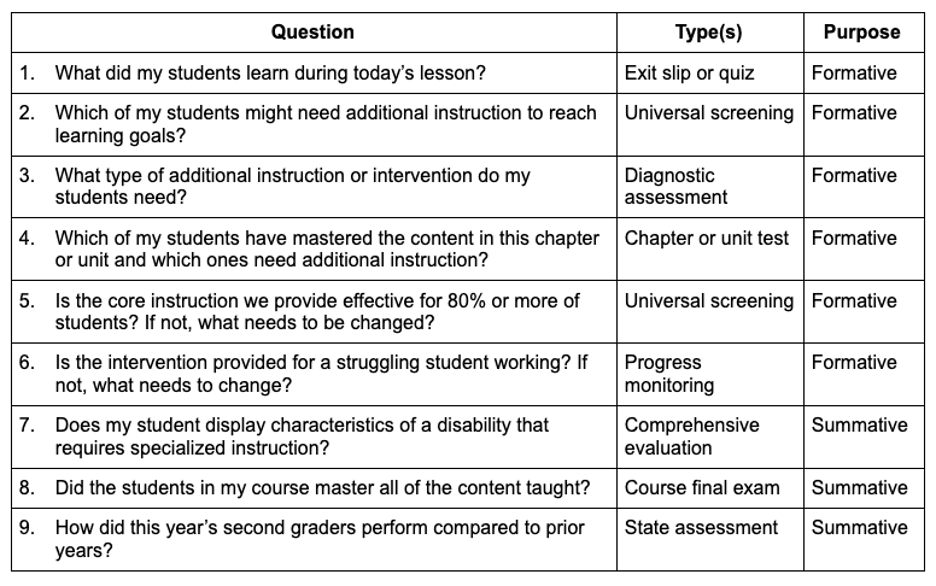December 9, 2021
Classroom formative assessment is widely used in schools. However, there are multiple definitions of this term. There can also be confusion around whether formative assessment is a process or a product.
So, what is formative assessment in education? And why is it so important? Let’s dive in.
What is formative assessment?
One popular way of thinking about formative assessment is that it “in-forms” instruction. The National Council on Measurement in Education (NCME) uses the following formative assessment definition:
“Formative assessment practices are those that provide teachers and students with information about learning as it develops—not just at the end of a project, unit, or year. The information is formative because it enables adjustments that deepen learning. Teachers use formative assessments to make adjustments to instruction, and students use the feedback from formative assessments to make revisions to their work and their approaches to it.”
The NCME definition does not indicate if formative assessment is specifically a product or a process, but it points more toward it being a process when stating that it relates to “information about learning as it develops.”
The Council of Chief State School Officers (CCSSO) defines formative assessment as a process that involves both students and teachers in the classroom:
“Formative assessment is a planned, ongoing process used by all students and teachers during learning and teaching to elicit and use evidence of student learning to improve student understanding of intended disciplinary learning outcomes and support students to become self-directed learners. Effective use of the formative assessment process requires students and teachers to integrate and embed the following practices in a collaborative and respectful classroom environment:
- Clarifying learning goals and success criteria within a broader progression of learning
- Eliciting and analyzing evidence of student thinking
- Engaging in self-assessment and peer feedback
- Providing actionable feedback
- Using evidence and feedback to move learning forward by adjusting learning strategies, goals, or next instructional steps.”
The CCSSO definition includes guidance concerning effective formative assessment practices, further emphasizing that it is a process and not a product.
Formative assessment vs. summative assessment
To some extent, all assessments are part of a larger process of learning. However, formative assessment is often contrasted with summative assessment in order to distinguish key features.
One of the primary differences between formative and summative assessments is that formative assessments are conducted at multiple time points during learning, whereas summative assessment happens only at the end of the learning. Thus, the repetition of formative assessments confirms that it is a process. That said, an assessment could be used for both formative and summative purposes.
Examples of formative vs. summative assessment purposes
There are many examples of classroom formative assessments, each designed to answer a specific question about student learning. The following table displays types of assessments commonly used in schools with examples of their formative and summative applications. Note that some of the assessments listed serve the same purpose, and not all of them are necessarily used in one school.

By definition, formative assessment is the action taken after the assessment to improve student learning. In this way, the data informs instruction. Formative assessments require a process in order to be helpful to students and teachers.
Summative assessments also provide important information about student performance, but the results are not used to modify individual student instruction. Instead, they are often used to review data from a group of students and identify patterns in performance by cohorts. In this regard, formative and summative assessments serve different purposes.
Use formative assessment for formative purposes and summative assessment for summative purposes
A formative assessment’s process depends on its function or purpose. An excellent way to define the purpose is by asking what question about student performance the assessment is designed to answer.
Here are common questions that teachers ask about student performance:
- What did my students learn during today’s lesson?
- Which of my students might need additional instruction to reach learning goals?
- What type of additional instruction or intervention do my students need?
- Which of my students have mastered the content in this chapter or unit and which ones need additional instruction?
- Is the core instruction we provide effective for 80% or more of students? If not, what needs to be changed?
- Is the intervention provided for a struggling student working? If not, what needs to change?
- Does my student display characteristics of a disability that requires specialized instruction?
- Did the students in my course master all of the content taught?
- How did this year’s second graders perform compared to second graders in prior years?
Some of these questions are best answered with formative assessments and others with summative ones. The following table shows each of the above questions with the type of assessment best suited and whether the assessment is formative or summative.

Neither formative nor summative assessments are “best.” Instead, each type should be matched to the assessment purpose and the question(s) the test is seeking to answer.
Remember, classroom formative assessment involves a process, and many steps and tools are typically used during this process.
Supporting formative assessment
Discover Renaissance solutions that help you to better understand students’ performance.
How to evaluate your own assessment system
A helpful activity that school leaders and teachers can do is to list all the assessments currently used in their school and then list the purpose of each assessment. Once all the assessments and their purposes are listed, it’s possible to see whether there are multiple tests used to answer the same questions.
Similarly, school leaders and teachers can list the questions they routinely ask about student performance and then match those questions to current assessments. If there are questions with no corresponding assessment, the team can discuss if it’s a question that must be answered. When it’s an essential question, an appropriate assessment should be selected to answer that question. Importantly, educators should strive to conduct as few assessments as possible to answer questions about student learning.
4 categories of formative assessment you can use in your classroom
Let’s break down some of the different ways you may use formative assessment with your students.
#1: Pre-assessment
Pre-assessment occurs before instruction of new content begins to find out what students know. It can also help teachers to identify any knowledge gaps or misconceptions surrounding the material. This pre-assessment can be used throughout the educational process to help students see what they have learned.
Some examples of pre-assessment include:
- Conversation
- Multiple-choice questions
- Use of writing prompts
- Creating a concept map
Pre-assessment is a powerful tool because it can—and should—be used to guide instruction. Pre-assessment results can also be used to help students set learning goals.
#2: Self-assessment
Self-assessment lets students reflect on their learning and the quality of their work thus far and then decide what their next steps should be. This isn’t about having students assign themselves grades or scores—it’s simply about feedback.
Self-assessment involves:
- Awareness of goals
- Checking progress
- Making adjustments as needed
Self-assessment should always be followed by opportunities to relearn a concept or revise work. Knowing they have room for improvement keeps students honest in their assessments.
#3: Peer feedback
These techniques allow students to give constructive and useful feedback to each other about their work. They don’t grade each other, but they may recommend revisions or possible next steps.
Peer feedback is a collaborative learning activity. It allows students to practice recognizing what success looks like in the work of others, which may help them better understand their learning goals.
#4: Feedback breaks
Feedback breaks are exercises that can be sprinkled throughout your lessons. They give teachers information about what and how the students are learning while allowing them to change and develop their understanding of new content.
Feedback breaks are self-assessment exercises built into parts of the lesson where it would be natural to pause and examine one’s thinking—for instance, after a concept has been introduced and before moving on to the next piece of content.
Feedback breaks help students put their understanding into words and process the new information. This also helps teachers evaluate student progress as they go and strategically use questions at pause points to help give direction to the rest of the lesson.
Some people refer to these as hinge-point questions because the way the lesson evolves hinges on students’ answers. A good example of a hinge-point question is a multiple-choice inquiry where some of the choices are common misconceptions.
Support the classroom formative assessment process with Renaissance
Renaissance offers a number of assessment tools that educators can use to understand their students’ performance. Remember, formative assessment is a process that involves selecting and using assessments aligned to the question the teacher seeks to answer. The following list includes types of assessments, the questions they address, and which Renaissance tool best answers the questions.
Just-in-time/short cycle assessment:
- Confirms that specific learning has taken place and provides data to inform instruction that follows
- Example: DnA
- Informs Tier 1 instruction and intervention; informs which students may need interventions to succeed; informs system-level resourcing
- Examples: FastBridge and Star Assessments
Diagnostic assessment:
- Pinpoints specific skill areas of need; diagnostic assessment ensures instructional supports are aligned with learning needs
- Example: Star Phonics
- Informs intervention decisions and whether to continue, adjust, or fade supports
- Examples: FastBridge and Star Assessments
Interim assessment:
- Informs whether students are mastering grade-level content or if adjustments should be made to improve end-of-year outcomes
- Examples: DnA; SchoolCity
Summative assessment:
- Informs system-level adjustments to curriculum, instruction, assessment, and scope and sequence to improve learning outcomes for all students
- Examples: DnA; SchoolCity
To learn more about these Renaissance assessments and how they support greater student growth, connect with an expert.

